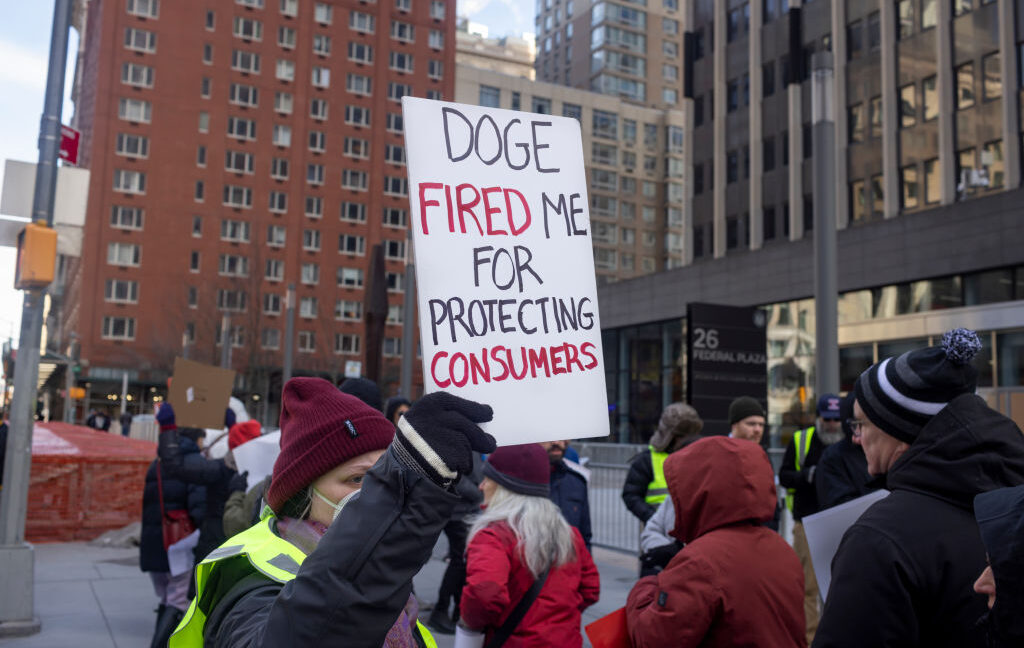"Workforce Reshaping Tool"
Report: DOGE supercharges mass-layoff software, renames it to sound less dystopian
Report: DOGE software automates layoffs, slashing biggest agencies in a blink.
Ashley Belanger
–
May 8, 2025 12:37 pm
|
54
Federal workers and protestors speak out against US President Donald Trump and Elon Musk, the tech billionaire, who is leading the so-called Department of Government Efficiency (DOGE), and their push to gut federal services and impose mass layoffs.
Credit:
Pacific Press / Contributor | LightRocket
Federal workers and protestors speak out against US President Donald Trump and Elon Musk, the tech billionaire, who is leading the so-called Department of Government Efficiency (DOGE), and their push to gut federal services and impose mass layoffs.
Credit:
Pacific Press / Contributor | LightRocket
Text
settings
Story text
Size
Small
Standard
Large
Width
*
Standard
Wide
Links
Standard
Orange
* Subscribers only
Learn more
Minimize to nav
The Department of Government Efficiency (DOGE) has reportedly overhauled a historically wonky Department of Defense-designed tool that automates layoffs of federal workers.
Expected to expedite DOGE's already rushed efforts to shrink the government, the redesigned software could make it easier for DOGE to quickly dismantle the biggest agencies in a blink, sources familiar with the revamp told Reuters.
Developed more than two decades ago, AutoRIF (short for automated reductions in force) was deemed too "clunky" to use across government, sources told Reuters. In a 2003 audit, the DOD's Office of the Inspector General noted, for example, that "specialized reduction-in-force procedures needed for the National Guard technicians made the module impractical." Basically, each department needed to weigh its cuts differently to avoid gutting essential personnel. Despite several software updates since then, Wired reported, the tool remained subject to errors, sources told Reuters, requiring most federal agencies to continue conducting firings manually rather than risk work stoppages or other negative outcomes from sloppy firings.
So far, DOGE has already cut an estimated 260,000 government workers who either were laid off or opted to take buyouts or retire early without using the updated software, a Reuters analysis found. But many more layoffs are coming, as larger agencies like the Department of Veterans Affairs and the Internal Revenue Service plot looming cuts of tens of thousands of workers.
In February, Wired first sounded the alarm that workers could soon be fired by an algorithm, and now sources have told Reuters much more about the DOGE-led effort. According to sources, AutoRIF has been rebranded as the "Workforce Reshaping Tool," which is apparently the government's attempt to find a more "benign-sounding name" than the somewhat dystopian-sounding AutoRIF.
The Workforce Reshaping Tool update was likely spearheaded by a former Tesla engineer, Riccardo Biasini, whose name is attached to a GitHub repository that Wired uncovered. Sources told Reuters that updates included creating a user-friendly web version of the tool, which can provide "targets for layoffs much more quickly than the current labor-intensive manual process."
Other improvements include a feature that makes it possible to upload employee data that human resources employees previously had to manually input. And where before AutoRIF could only be accessed by one user to manage an entire agency's layoffs, updates also included enabling multi-user access, which is expected to speed up approvals to further expedite layoffs.
In the coming weeks, agencies will get access to this web version for demos and testing, Reuters reported, while noting that the tool appears to be the "only known example" of DOGE following through on its mission to modernize the federal government.
Supercharging DOGE’s rushed cuts—what could go wrong?
DOGE has been hit with immense backlash for rash cuts, sparking protests after it gutted popular agencies and mistakenly fired probationary workers who had to be rehired, either because a court ordered reversals of illegal firings or department heads later flagged laid-off workers as mission-critical.
The Elon Musk-led agency is also facing lawsuits seeking to stop mass layoffs, many of which still name Musk as a defendant, despite his recent decision to step away from DOGE to put out fires at Tesla. In particular, efforts to demolish the Consumer Protection Financial Bureau, which some critics suggest would be a gift to Musk, have sparked protests, while Democrats complained that DOGE seemed to be targeting agencies for cuts that could spare Musk billions in penalties. And certainly among the most recently damning to DOGE's public image, in an interview announcing the sunsetting of the Gates Foundation today, Bill Gates criticized Musk's DOGE cuts at United States Agency for International Development for "killing children."
It seems unlikely that the Workforce Reshaping Tool by any name could fix DOGE's popularity problem, especially if the tool still makes errors but at a much faster clip, experts have warned.
A law fellow with the nonprofit Electronic Privacy Information Center, Abigail Kunkler, warned in a March blog that more transparency is needed about AutoRIF's updates.
"It is not clear how AutoRIF has been modified or whether AI is involved in the RIF mandate (through AutoRIF or independently)," Kunkler wrote. "However, fears of AI-driven mass-firings of federal workers are not unfounded. Elon Musk and the Trump Administration have made no secret of their affection for the dodgy technology and their intentions to use it to make budget cuts. And, in fact, they have already tried adding AI to workforce decisions."
Automating layoffs can perpetuate bias, increase worker surveillance, and erode transparency to the point where workers don’t know why they were let go, Kunkler said. For government employees, such imperfect systems risk triggering confusion over worker rights or obscuring illegal firings.
"There is often no insight into how the tool works, what data it is being fed, or how it is weighing different data in its analysis," Kunkler said. "The logic behind a given decision is not accessible to the worker and, in the government context, it is near impossible to know how or whether the tool is adhering to the statutory and regulatory requirements a federal employment tool would need to follow."
The situation gets even starker when you imagine mistakes on a mass scale. Don Moynihan, a public policy professor at the University of Michigan, told Reuters that "if you automate bad assumptions into a process, then the scale of the error becomes far greater than an individual could undertake."
"It won't necessarily help them to make better decisions, and it won't make those decisions more popular," Moynihan said.
The only way to shield workers from potentially illegal firings, Kunkler suggested, is to support unions defending worker rights while pushing lawmakers to intervene. Calling on Congress to ban the use of shadowy tools relying on unknown data points to gut federal agencies "without requiring rigorous external testing and auditing, robust notices and disclosure, and human decision review," Kunkler said rolling out DOGE's new tool without more transparency should be widely condemned as unacceptable.
"We must protect federal workers from these harmful tools," Kunkler said, adding, "If the government cannot or will not effectively mitigate the risks of using automated decision-making technology, it should not use it at all."
Ashley Belanger
Senior Policy Reporter
Ashley Belanger
Senior Policy Reporter
Ashley is a senior policy reporter for Ars Technica, dedicated to tracking social impacts of emerging policies and new technologies. She is a Chicago-based journalist with 20 years of experience.
54 Comments










